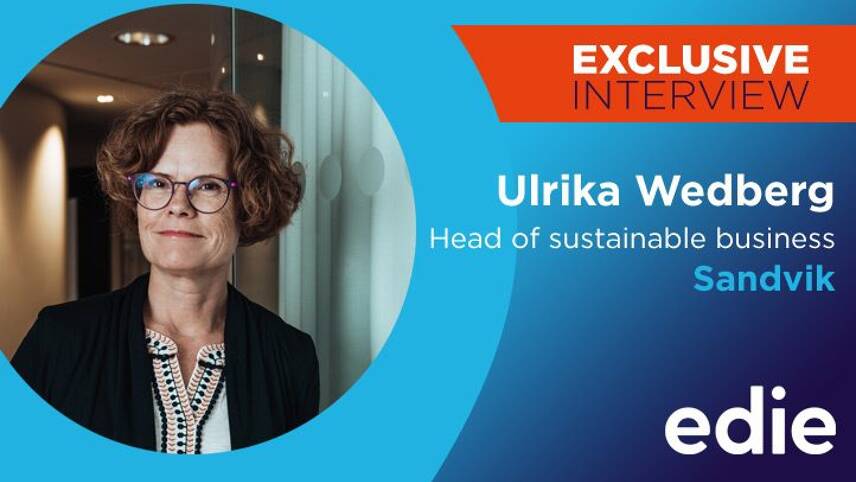Register for free and continue reading
Join our growing army of changemakers and get unlimited access to our premium content

Wedberg wants Sandvik employees to collectively submit 100
Sandvik may not be a well-known name here in the UK, but the business is one of the largest in its sector globally with more than 42,000 employees and operations in 160 countries. It operates across its three key business areas – mining and rock technology; machining and materials technology – which have historically been considered carbon-intense and hard-to-abate.
Last month, the company unveiled a sweeping new set of sustainability pledges that it claims will represent a “shift on climate and sustainability. Set under the frameworks of the Paris Agreement and the UN’s Sustainable Development Goals (SDGs), the pledges include commitments to halve Scope 1 and Scope 2 carbon emissions and achieve 90% circularity across all materials and projects.
Speaking exclusively to edie, Sandvik’s group head of sustainability Ulrika Wedberg detailed the first steps the company will take towards these aims. For reducing carbon, she explained, electrifying fleets, sourcing more renewable electricity, using biogas for heating and investments in energy efficiency systems will be key.
But perhaps a more unusual facet of Sandvik’s approach will be the creation of an “ideas hub” – a digital system whereby all staff can submit sustainability ideas and innovative concepts. Sandvik is targeting 100,000 submissions to the hub by 2030 and, according to Wedberg, is already well on its way.
“Normally, when you give people a new task, they tell you they are busy and can’t take on another duty as well – but when we presented our goals, there was an enormous attendance and we could see right away that people were keen to put forward their own ideas,” she said.
“It’s very much in the DNA of engineers to ask how their work can make customers more productive and, over time, they’ve increasingly been focused on decreasing carbon intensity as well. These two aims are not different – producing less waste, using fewer resources and becoming less dependent on diesel are all cost-cutting opportunities now.”
To incentivize the use of the hub, Sandvik will issue prizes to teams on an annual basis, under categories such as biggest carbon reduction and greatest positive health and wellbeing impact. Innovations which win these accolades will be trialled internally as a starting-point before Sandvik decides whether they should become a new business stream or be open-sourced.
According to Wedberg, the launch of the hub represents the next step in Sandvik’s drive to move sustainability away from being a “separate business function” and make it a “business-as-usual” priority.
“We see sustainability as a business advantage, and to make that work to the fullest, it needs to be integrated everywhere,” she said. “It’s crucial that everyone knows what part they can play, within their role.”
Bold goals
Wedberg’s comments come at a time when more and more businesses of all sectors and sizes are working to make environmental and social improvement a key part of all roles, rather than a priority for the sustainability team alone.
Perhaps the most famous example of this is Unilever, which asked its 172,000 staff to help create its upcoming sustainability strategy. More broadly, 40% of respondents to edie’s recent Sustainable Business Leadership Survey said that in the future there should be no standalone sustainability function at all.
Another key facet of future-proof sustainability leadership, Wedberg told edie, will be setting ambitious, long-term goals – regardless of whether companies can immediately see a clear path to achieving them.
She explained that tracking progress on Sandvik’s new circularity target will require the development of an entirely new set of metrics capable of accounting for activities ranging from upcycling and downcycling, to prolonging product life and rental schemes. A further challenge in developing these metrics lies in the fact that the definition of “circularity” is likely to vary between Sandvik’s three key business areas.
But Wedberg remains optimistic.
“Setting these goals has put us in a place where we know where we’re heading and are well aware of needing to put every step in place to get there,” she said. “This is an engineering company, so people know how we can innovate to get there – we just need to start collecting that information at the right level.”
In order to gain boardroom buy-in for working towards long-term goals bolder than Sandvik has set before, it will soon begin linking the bonuses of top-level managers with progress on its sustainability targets, Wedberg added.
Her team is also pressing for sustainability progress to be reported internally on a quarterly basis, as is currently the norm for financial reporting.
“We need hard facts and hard numbers – not someone thinking or feeling – to drive the necessary reductions,” she concluded. “That way, money can be attached to progress.”
Sandvik is not alone in taking this approach. Recent months have seen the likes of Royal Dutch Shell, BP and Chevron begin to alter executive-level pay or bonuses to progress on their carbon reduction aims.
Sarah George


Please login or Register to leave a comment.